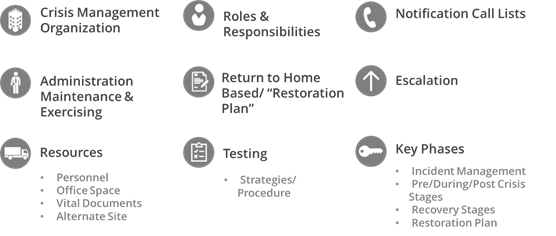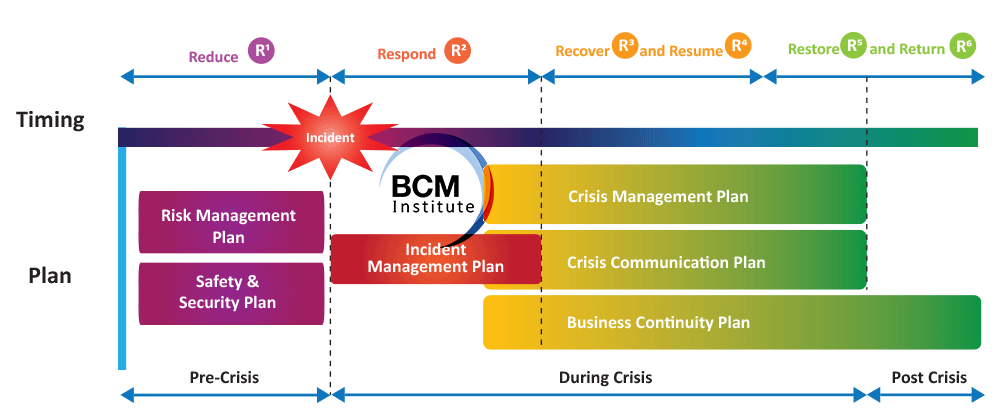Document the CM System
The primary objective of any CM plan is to establish a flexible structure capable of responding to any crisis quickly, decisively, and coordinatedly.
 The criteria for developing a best-practice CM manual will be thoroughly explained and discussed.
The criteria for developing a best-practice CM manual will be thoroughly explained and discussed.
Practical examples of best-practice CM manuals will be compared with current documentation.
The key criteria for implementing the CM procedures and manual include:
- Having user-friendly content during a crisis;
- Being prescriptive about who takes responsibility for what and
- Providing an audit trail for post-incident investigation.
The CM plan should establish:
- Relationships;
- Responsibilities; and
- Continuity.
- A notification system with a specific and up-to-date listing of current contact information on the team members, a chain of command, and relevant external agencies;
- The identification of a CM team;
- An assessment of the most likely crisis scenarios;
- The development of a CM Plan document;
- Periodic crisis training exercises and
- Adherence to crisis communication guidelines and continual CM Plan review and refinement.
Crisis Management Plan

A crisis management plan may include the following:
- Crisis risk management documentation, such as
- Communications strategies
- Issue tracking
- Risk assessments and evaluations
- Risk management team lists
- Risk registers
- Treatment strategies
- Vulnerability profiles
- initial response instructions for various roles and areas
- emergency response structure
- program review and monitoring processes
- resource inventory for response and recovery
- responsibility and authority of individual roles
- warning systems

Component of CM, IM and BC Plan with the 6 Rs
Prepare a Plan Ahead
One of the best tools for managing a crisis is a well-conceived, ready-to-go CM plan that can be activated when one occurs. Having a plan and training the staff for an emergency in advance is key to protecting and enhancing the organization’s reputation.
The CM approach plan should describe the nature of the brand and the corporate reputation that the organization wants to protect. This CM plan should consider the potential impact of different crisis scenarios. For example:
- What would happen if a fire occurred and the organization is unable to fulfil a vital contract?
- What if someone contaminated an organization’s primary product?
- How does an organization handle a product recall?
- How would a drop in the stock price affect the organization’s reputation?
Crisis Communication Plan Content
A Crisis Communication Plan should include:
- A press kit;
- The background material for media information;
- The list of critical media outlets;
- The pre-prepared statements for a variety of risk situations;
- A generally prepared statement that projects a responsible image;
- A series of talking points for potential crises that can be identified in advance and
- The roles and responsibilities of the Crisis Communication team.
 Refer to Manage Crisis Communication for the detailed process for managing crisis communication. Click here for more details on how to appoint a designated spokesperson.
Refer to Manage Crisis Communication for the detailed process for managing crisis communication. Click here for more details on how to appoint a designated spokesperson.
The crisis communication plan does not need to be a comprehensive, highly detailed document since it cannot cover all crises. However, it should provide a flexible, action-oriented CM Plan that can be easily adapted.
Select CM Team Leader
When setting up a CM Team, the team leader must be:
- Identified and pre-selected to deal with crisis management;
- A senior management staff member or a director with the authority and experience to make decisions in what could be difficult circumstances and
- Someone who can step away from his or her day-to-day responsibilities to lead the crisis team should a crisis happen.
Organise the Team
The CM Team Leader should:
- Make provisions for a flexible management structure in the event of a crisis
- Identify representatives from key operational and policy areas and inform them of their responsibilities during a potential crisis.
- Identify representatives who can meet the information needs of different stakeholders, such as consumers, regulators, the media, employees, and stockholders, who would view a crisis from different perspectives.
Crisis-related problems usually bring together diverse interests. They include the following:
|
Functional Specialist |
Skillset |
|
Technical |
Explain the product or operational issues. |
|
Marketing |
Advise on customer communication requirements. |
|
Finance |
Assess the financial implications of the crisis. |
|
Public Relations |
Deal with the media. |
If an organisation does not have functional specialists responsible for each area, it may need to identify people with relevant skills or brief an agency to provide standby support.
Prepare an Action Plan
Your action plan should detail the events that should happen after a crisis occurs. Each response team member will be responsible for gathering information and reporting it to the rest of the team. They should, therefore, have an up-to-date list of internal and external contacts for their particular area of responsibility.
The action plan should cover some key points, including:
- The point at which the CM plan will be activated;
- The person to be alerted when the CM plan is activated and
- The method of communication between CM team members and their primary contacts.
The action plan should identify the spokesperson dealing with media and other inquiries. Ideally, the spokesperson will have media training but should also have the level of responsibility and seniority to make credible statements.
Although it may seem easier to give responsibility for this frontline role to a public relations consulting firm, it may be more appropriate for the company to handle its media response, as this demonstrates a commitment to resolving the crisis.
Identify Crisis Points
Every organization has crisis points. Crisis Points about an organization should be closely examined, and these include:
- Controversial personnel;
- Products or services;
- Internal philosophical conflicts;
- Weak managers;
- Known instances of communication breakdowns and
- Changing public attitudes.
What If?
"What if?" is a valuable question to ask in CM. Futuristic scenarios and model solutions based on an organization's vulnerable spots can remove surprises in the next crisis and give it a head start in dealing with such situations.
Fact-find During Non-crisis Periods
As you identify crisis points and construct scenarios, you should routinely gather, sort, and classify information relevant to your organization, including rumours.
Classify the information
Classify the information into facts and myths.
- Facts should be routinely updated.
- Rumours should be verified or exposed as myths.
Select the Right CM Team Members
All organizations need a CM team. They are a group of pivotal players that perform key functions during a crisis. These crucial players must be prepared to work around the clock, if necessary, for successful crisis management. The identity of these crucial players should not be high profile within the organization lest they become compromised before, during, or even after a crisis.
Each member should receive routine CM training and be updated regularly on potential crisis points, facts, and myths.
By developing a list of qualified personnel in different areas of an organization who could serve in this role, the organization has improved its flexibility to respond to a crisis. The organization is expected to benefit from a good list of contacts that can be called on to respond to various issues to prevent crises.
Surviving a Crisis
However unpleasant a crisis may be, it will eventually end. Your hope, of course, is that it will end quickly with a minimum of damage to your organization. A crisis can have a positive outcome for your organization.
Summing Up ...
Effective crisis management can legitimize an organisation's mission or clarify its role. It can also provide a fresh start or a new opportunity for your management team or organization.
Moreover, because top management is willing to deal with the crisis openly, how the crisis is managed can often promote positive opinions about your organisation among the public and employees.
Goh, M. H. (2016). A Manager’s Guide to Implement Your Crisis Management Plan. Business Continuity Management Specialist Series (1st ed., p. 192). Singapore: GMH Pte Ltd.
More Information About Crisis Management Blended/ Hybrid Learning Courses
To learn more about the course and schedule, click the buttons below for the CM-300 Crisis Management Implementer [CM-3] and the CM-5000 Crisis Management Expert Implementer [CM-5].









![[BL-CM] [5] Register](https://no-cache.hubspot.com/cta/default/3893111/82024308-16f4-4491-98be-818a882c6286.png)

![Email to Sales Team [BCM Institute]](https://no-cache.hubspot.com/cta/default/3893111/3c53daeb-2836-4843-b0e0-645baee2ab9e.png)





